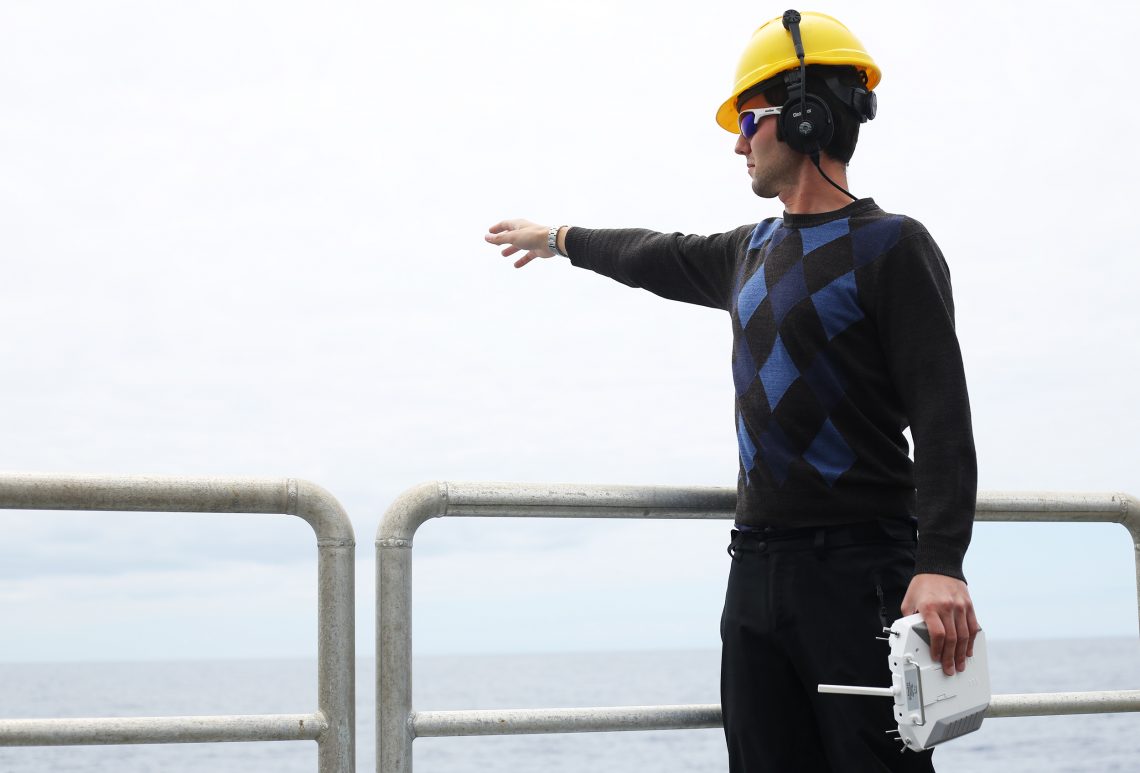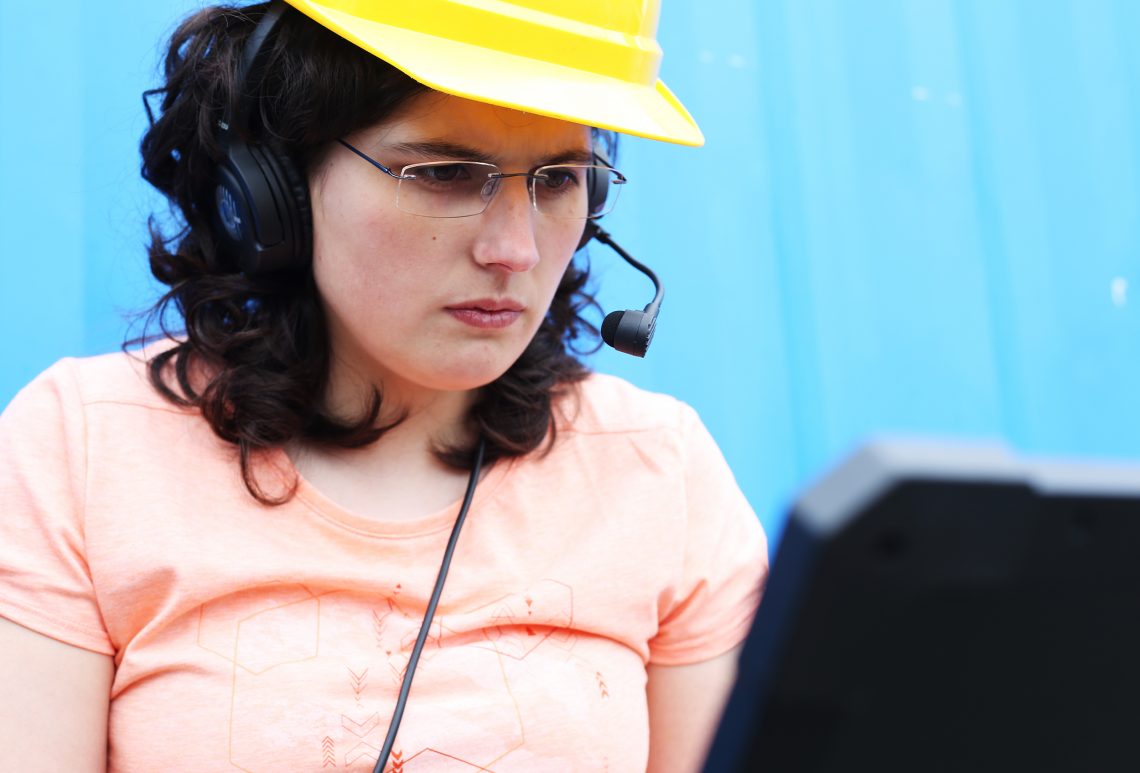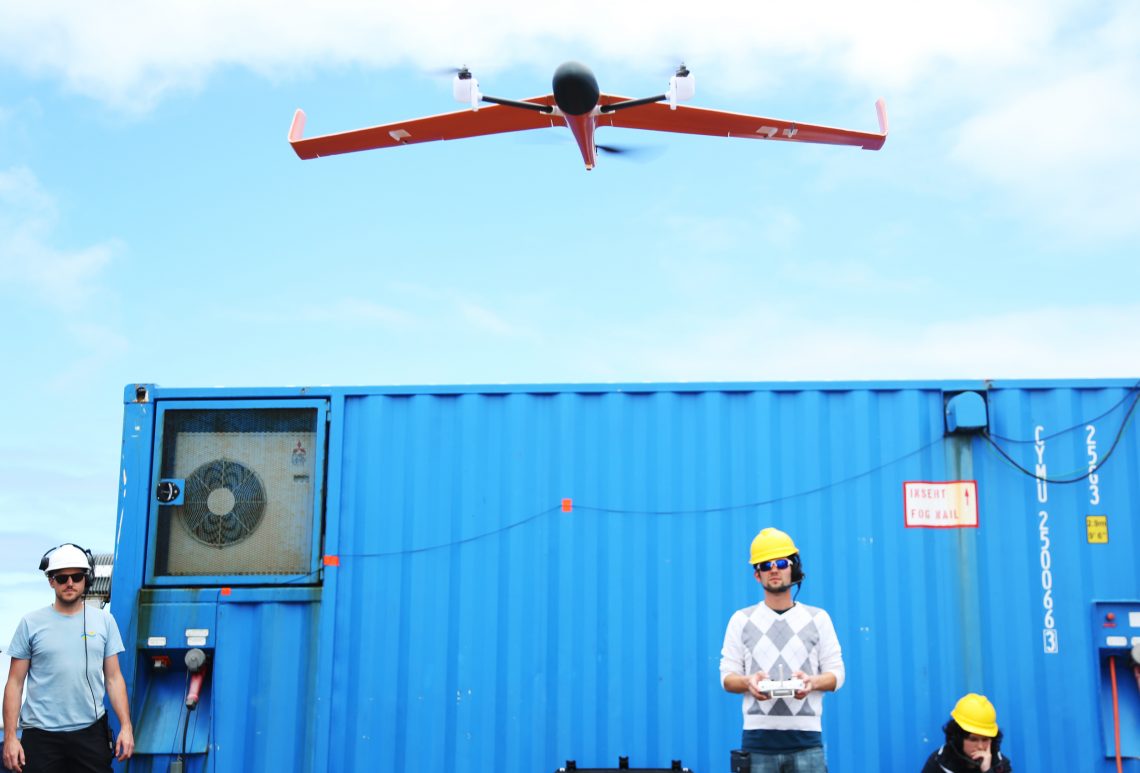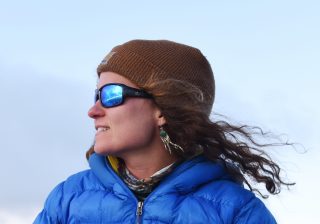Trent Lukaczyk walks to the starboard side of the storage deck and sticks his right hand over the railing. Like rolling down a window in a moving car, a sudden gush of wind prickles his fingers. By his estimate, it is currently blowing at 15 knots and gusting nearly 20 knots.
Blocked on two sides by large shipping containers, the storage deck creates a bubble of still air within the otherwise windswept upper level of R/V Falkor. On a square wooden platform in the middle of the deck, a bright orange drone emits melodic robot sounds and wiggles its propellers. As Trent and his co-pilot, Maria Costa, run through final system checks, Trent considers the aircraft’s path — it will take off, hover for just a few seconds, and then meet a blast of air as soon as it crosses the railing.

“I have to sneak the drone out into the windy part,” he says. “It’s kind of a rough environment and the drone has to be able to handle that.” Testing robotic systems that can handle conditions in the middle of the ocean is what this expedition is all about. And constructing UAVs robust enough to withstand the elements is exactly what Trent Lukaczyk does.
While the Falkor is currently housing seven different aerial drones (as well as several underwater autonomous vehicles), this particular piece of aerial technology is unlike the others. The fixed-wing platform, designed by Trent and his team at Flightwave, looks like a small airplane but can take off and hover like a quadcopter.
Like a traditional airplane, this UAV can use wind to its advantage. The long swept wings (made of carbon and fiberglass) give it lift. Like a helicopter, it can hover at any point in the sky. The tilting propellers point up to give it thrust. In an even more unique feature, the two ideas work together even while the UAV is hovering: “If it’s windy, we can hover longer and use less power than if there was no wind.”
Reason and Distance
Why build a vertical take-off airplane in the first place? To fly longer and farther.
Five years ago, Trent assisted a team of biologists by flying a quadcopter in American Samoa to capture transects of coral reefs. While he collected good data, he quickly became frustrated by the short duration of each flight due to the limited battery life. “Quadcopters give you a lot of flexibility,” he says. “It’s great to be able to land on a small sandy patch between two lava rocks—but a 20-minute flight isn’t long enough.” At that point, building drones was a hobby. It soon became a business venture with big aspirations— to build drones that can fly in hard-to-reach places – such as the middle of the Pacific Ocean.
As the Flightwave Edge powers up, Maria and Trent approach the task at hand with focus and fastidiousness. They maintain constant contact with the bridge, while two marine technicians stand by with a fire extinguisher in case anything goes wrong. All of us don hard hats and eye protection. “My primary role here is to get it off the ship,” Trent says. “I put it in the air and then give control over to Maria.”

Within seconds the drone lifts off from the platform and zooms out over the water. A gust of wind causes the right wingtip to dip, but the aircraft recovers and flies smoothly 60 meters above the ocean surface. Maria loads in waypoints for the aircraft to follow. The current payload is taking thermal images (one every second) to measure sea surface temperature, but Trent and Maria can easily interchange two other sensors. Similar to interchangeable lenses on a DSLR camera, the nose cone on the front of the aircraft can twist on and off. In addition to the thermal imaging camera, the team also has a multi-spectral camera that can pick up the presence of chlorophyll-based organisms like plankton, as well as a brand-new sensor developed by NASA, which detects a gas called Dimethyl Sulfide (DMS). Emitted by phytoplankton, this gas rises to the water’s surface, giving oceanographers another way to detect fronts.
Balance in the Air, on the Ground, and at Sea
Being a drone engineer and pilot requires balancing risk and responsibility with pushing the limits—and an enormous amount of patience. In five years of building and flying drones for fun and for work, Trent estimates he has dealt with close to 100 crash landings. His motto is fail early, fail often.
But he has also made tremendous progress, which has brought him to this unique opportunity—flying his drone off a research vessel in the middle of the Pacific. And like the aircraft he has engineered, Trent remains steadfast. “The most rewarding things in life are also the hardest,” he says. “Flying a drone in the middle of the ocean is an extremely hard thing.”
But he makes it look easy.


